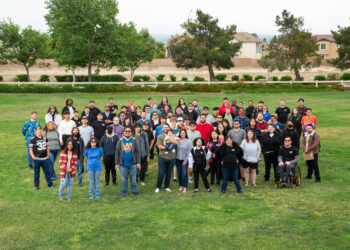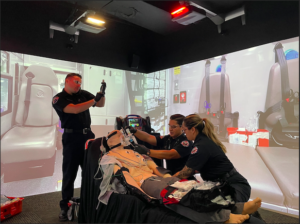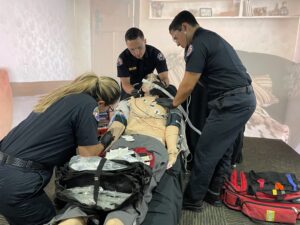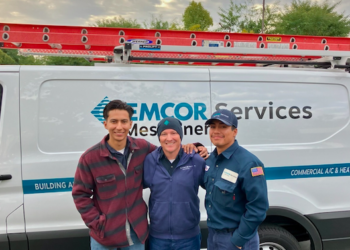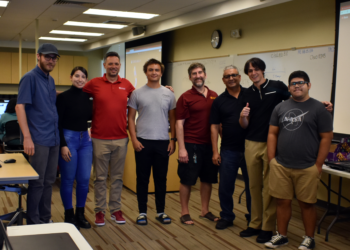Breaking Barriers: Innovative Simulation Room Equips Moreno Valley College EMS Students
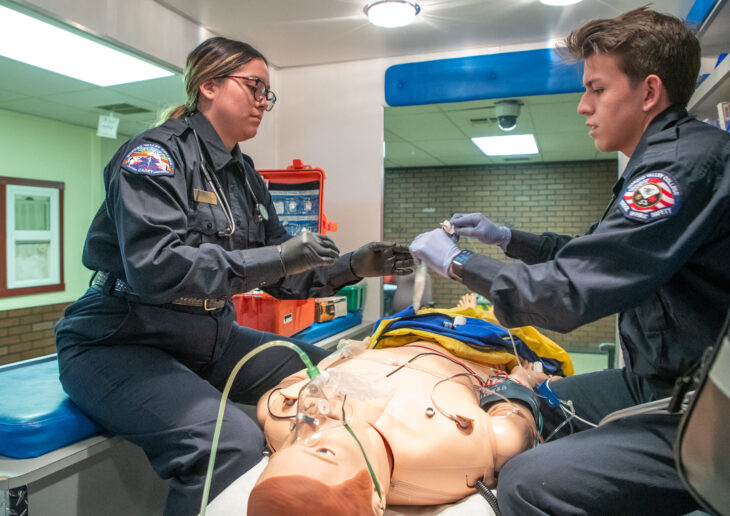
When it comes to innovation, Moreno Valley College is ahead of the game.
With the addition of the PRISM simulation room, students within the Emergency Medical Services (EMS) programs are getting the field experience without leaving the Riverside County campus.
The high-tech room includes projections of real-life environments with content captured from throughout the county. Given the footage is sampled from public areas, businesses, medical facilities, and homes from throughout the county, it serves to immerse the paramedic student in real-life scenes they will likely recognize or encounter in the field. Three of the four walls feature the projections as an interactive high-fidelity mannequin sits in the middle of the room. This mannequin is operated in real-time by a faculty member that not only simulates patient dialogue and character development, but can observe and guide the students remotely while watching on monitors in the control room.
“The simulation [room] allows our faculty to create a wide variety of scenarios for our students and to adjust the outcomes of a patient encounter,” says Robert Fontaine, Department Chair and EMS Director at Moreno Valley College. In addition, high-fidelity simulation equipment provides the students the ability to critically think through challenging patient types and have the difficult conversations in an environment that represents the places where they will encounter patients.
“In order to be competitive, we need to look at technology and simulation to train and educate the future of Emergency Medical Service (EMS) professionals,” Fontaine continues.
Faculty members can create a unique simulation room to give students a fully immersive experience by customizing the lighting, visuals, audio, and other environmental features. Fontaine explains that “the use of the PRISM system allows faculty to create realistic scenes in a controlled environment, allowing the student to perform in a simulation setting.”
In addition, scenes may be built out with features and transitions that are controlled interactively by the students or manually by the operator. These scene changes may include the initial location that the patient was found, to a code 2 or code 3 transport in the back of an ambulance, and ultimately, concluding at the emergency room. These capabilities allow the students to become more aware of scene management and the timing of treatment modalities as they progress through the patient encounter.
The groundbreaking software is taking learning to a whole new level. The PRISM system, which allows the simulation room to operate, is an interactive digital platform that focuses on a visual, auditory, and sensory experience for students. Instructors can also use the system to give immersive presentations and create virtual escape rooms, in addition to designing realistic training scenarios. The multi-sensory cues of this immersive environment demand real-life consideration.
By adding this asset to the program, paramedic students at Moreno Valley College can get valuable experience without leaving campus. This benefit was especially helpful during the global pandemic, when restrictions prevented students from attending their clinical trainings.
“As a national accredited paramedic and EMT program, the use of simulation is required to ensure our students are trained in all areas of patient care,” Fontaine explains.
“This became an important part of training during the Covid 19 outbreak with the decrease access to our clinical sites.”
Even though real-life patients can’t be replaced, using the simulation room allows students to sharpen their skills and learn to work under pressure before going in the field — or even practice for scenarios they might not encounter during their time in clinicals.
“The students are limited on the types of patient encounters in their clinical settings,” Fontaine notes. “And the use of simulators allows for a wide variety of patient care responses and treatments.”
Employment in the healthcare industry is expected to grow at a rate of 18 percent from 2016 to 2026. As one of the top industries in the state and country, Moreno Valley College is ahead of the curve in innovating their health-focused programs.
“The future of medical education and training requires faculty to use all areas of patient assessment,” Fontaine says. “This includes human and simulation interactions to ensure the patient our students treat and transport are cared for at the highest level.
“The PRISM simulator allows for a wide range of patient care settings and reduces the stress for our EMS providers.”
As the immersive, interactive, and adaptive aspects of simulation continue to improve, the students’ transition into real-life application will become increasingly seamless.
